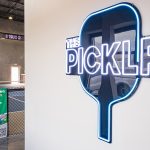Gildan Activewear reported sales in the second quarter rose 225 percent over last year and were down approximately 7 percent from record second-quarter 2019 sales. Earnings topped Wall Street’s targets. The gains came despite supply chain constraints.
The company also announced the approval by its Board of Directors for the reinstatement of its share buyback program to repurchase up to 5 percent of its issued and outstanding common shares.
“Our business continued to build momentum during the second quarter as economic activity in North America trended positively and the power of our Back to Basics strategy continued to drive stronger profitability,” said Gildan president and CEO, Glenn J. Chamandy. “Once again, our team demonstrated exceptional operational capability by delivering on our targets while navigating through a tight supply chain environment.”
Gildan generated sales of $747 million in the second quarter, up 225 percent over last year and down approximately 7 percent from record second-quarter 2019 sales. Wall Street’s consensus estimate had been $702.61 million.
The overall margin performance in the quarter was strong, improving both sequentially and from pre-pandemic levels in the second quarter of 2019. Gross margin totaled 32.2 percent and adjusted gross margin1 was 30.5 percent, which, when excluding the one-time 300 basis points (bps) benefit from the USDA pandemic assistance payment in the first quarter of 2021, was up sequentially by 320 bps and 240 bps, respectively. Gross margin performance also improved significantly over the second quarter of 2019, up 440 bps and 270 bps on an adjusted basis. Selling, general and administrative (SG&A) expenses in the quarter came in at 10.7 percent of sales, improving 170 bps from the first quarter of 2021 and 80 bps from 11.5 percent in the second quarter of 2019. Consequently, Gildan delivered GAAP diluted EPS of 74 cents a share and adjusted diluted EPS of 68 cents, reflecting a significant recovery over the loss incurred last year due to the effects of the onset of the pandemic. Compared to the second quarter of 2019, EPS and adjusted diluted EPS in the quarter were up 51 percent and 21 percent, respectively. Wall Street’s consensus estimate had been 50 cents.
Free cash flow of $208 million was a record for the second quarter, bringing its year-to-date total to $246 million and its available liquidity position to approximately $1.3 billion. Net debt further declined to $362.5 million and its net debt to adjusted EBITDA ratio decreased to 0.6 from 2.1 at the end of the first quarter this year and 3.5 at the end of 2020. With the company’s net debt leverage ratio1 now below its historical target range of one to two times net debt to adjusted trailing twelve months EBITDA, driven by the strong recovery to date and the progress of its Back to Basics strategy, and with the company’s prospects for continued free cash flow generation, its Board approved the resumption of its share buyback program to repurchase up to 5 percent of the company’s outstanding shares effective August 9, 2021.
Q2 2021 Operating Results
Net sales for the second quarter ending July 4, 2021, totaled $747.2 million, up 225.3 percent over the prior year, driven primarily by higher sales volumes and a favorable product mix. Activewear sales in the second quarter of 2021 totaled $597.1 million, up 353.7 percent over the prior year. The increase reflected significantly higher unit sales volumes in all markets, particularly in imprintables, driven by the strong recovery in point-of-sales (POS) and the non-recurrence of significant distributor inventory destocking which occurred in the second quarter last year. The recovery in demand also drove higher unit sales for its activewear products sold in retail channels. Sales in the hosiery and underwear category of $150.0 million in the quarter were up 52.9 percent over the prior year driven by double-digit POS growth in both socks and underwear, the non-recurrence of retailer inventory destocking and a favorable product mix.
Sales in the quarter compared to pre-COVID levels in the second quarter of 2019 were down 6.8 percent, due primarily to lower activewear sales volumes, unfavorable mix and lower net selling prices in imprintables, offset in part by higher underwear sales volumes. While imprintables demand levels have not fully recovered to pre-pandemic levels, Gildan said it was pleased to see improving POS trends in the quarter, in particular in North America. Gildan’s overall imprintables POS was down approximately 8 percent compared to the same period in 2019, with POS in North America down in the single-digit range, while POS in international imprintables markets remained weak, down close to 30 percent compared to the same period in 2019. In retail, overall POS was up during the quarter compared to the second quarter of 2019.
In the second quarter of 2021, Gildan generated a gross profit of $240.8 million, or 32.2 percent of sales, and an adjusted gross profit1 of $228.1 million, or 30.5 percent of sales, after excluding a net insurance gain of $12.7 million in the quarter. This compared to a gross loss of $148.5 million and $122.5 million on an adjusted basis in the second quarter last year. The significant improvement over 2020 was mainly due to the strong recovery in sales, the non-recurrence of COVID and Back to Basics-related charges incurred in the prior-year quarter, favorable product mix, lower raw material costs and cost benefits stemming from its Back to Basics initiatives.
Compared to the second quarter of 2019, gross margin and adjusted gross margin in the second quarter of 2021 were up 440 bps and 270 bps, respectively, from gross margin and adjusted gross margin of 27.8 percent, mainly driven by lower cotton costs and Back to Basics cost savings, which more than offset lower imprintables selling prices compared to 2019.
SG&A expenses for the second quarter of $79.7 million were up $14.8 million compared to SG&A expenses of $64.9 million last year. The year-over-year increase was primarily due to higher variable compensation expenses and higher volume-driven distribution costs, partially offset by cost savings stemming from its Back to Basics initiatives. SG&A expenses as a percentage of sales improved to 10.7 percent compared to 28.3 percent of sales last year driven by SG&A leverage from higher sales and Back to Basics cost benefits.
Compared to the second quarter of 2019, SG&A expenses were down approximately $12 million, largely attributable to cost benefits stemming from its SG&A rationalization efforts in connection with its Back to Basics strategy. As a percentage of sales, SG&A expenses of 10.7 percent in the quarter improved by 80 bps compared to 11.5 percent of sales in the second quarter of 2019.
Gildan generated operating income of $159.7 million, or 21.4 percent of sales and adjusted operating income1 of $148.6 million, or 19.9 percent of sales, in the second quarter of 2021 compared to an operating loss of $236.1 million and $181.1 million on an adjusted basis1 last year. The significant recovery was driven by higher sales, strong gross margin performance and SG&A leverage. Net financial expenses were down $9.6 million over the prior year mainly due to lower average debt levels and the non-recurrence of fees incurred in connection with the amendments made to its long-term debt facilities last year, which offset higher income taxes. Consequently, Gildan reported net earnings of $146.4 million, or $0.74 per share on a diluted basis, for the three months ended July 4, 2021, and adjusted net earnings of $135.3 million, or $0.68 per share on a diluted basis, compared to a net loss of $249.7 million, or $1.26 per diluted share, and an adjusted net loss1 of $196.6 million, or $0.99 per diluted share, respectively, in the second quarter last year.
Compared to the second quarter of 2019, the adjusted operating margin of 19.9 percent in the second quarter of 2021 was up 360 bps from 16.3 percent, driven by a stronger gross margin and SG&A performance. While sales levels have not fully recovered to pre-pandemic levels, the strength of its operating margin performance delivered in the quarter is a testament that its Back to Basics strategy is working and is driving more profitable growth. Consequently, Gildan delivered adjusted diluted EPS growth of 21 percent in the quarter compared to adjusted diluted EPS of $0.56 in the second quarter of 2019.
Gildan generated a free cash flow of $208 million, a record for a second quarter, compared to $177 million last year and $26 million in 2019. The year-over-year increase in free cash flow was primarily due to higher operating earnings and an $18 million net cash impact from insurance proceeds, partly offset by higher accounts receivable balances driven by the sales recovery, a lower inventory drawdown compared to last year when Gildan serviced sales with existing inventory levels while facilities were closed, as well as higher capital expenditures relating to manufacturing capacity. The company ended the second quarter of 2021 with net debt of $362.5 million and a net debt leverage ratio of 0.6 times net debt to trailing twelve months adjusted EBITDA, below the company’s historical target leverage range and down from 2.1 at the end of the first quarter of 2021.
Year-To-Date Operating Results
Net sales for the six months ended July 4, 2021, of $1,336.7 million were up 94.1 percent over the same period last year, reflecting increases of 114.5 percent in activewear sales and 38.1 percent in the hosiery and underwear category. The year-over-year increase in activewear sales where the company generated sales of $1,081.7 million was primarily driven by volume increases in all channels and favorable product mix. Higher imprintables sales volumes were driven by positive POS and the impact of the non-recurrence of destocking by distributors which occurred in the same period last year. The increase in the hosiery and underwear category where Gildan generated sales of $255.0 million in the first half of 2021 reflected strong growth both in underwear and in sales of sock products and a favorable product mix.
Gildan generated a gross profit of $429.3 million, or 32.1 percent of sales, and an adjusted gross profit of $411.5 million, or 30.8 percent of sales for the first half of the year compared to a gross loss of $41.9 million and an adjusted gross loss of $7.9 million for the same periods last year. The significant year-over-year improvement in adjusted gross margin was mainly due to the non-recurrence of COVID and certain Back to Basics related charges incurred in the first half of 2020, cost benefits from its Back to Basics initiatives, favorable product mix and lower raw material costs.
SG&A expenses in the first six months of 2021 totaled $153.1 million, or 11.5 percent of sales, up $14.2 million from $138.9 million, or 20.2 percent of sales, in the same period last year reflecting increases in variable compensation expenses and volume-driven distribution costs, partly offset by cost savings stemming from its Back to Basics initiatives.
On a year-to-date basis, Gildan generated an operating income of $273.5 million, or 20.5 percent of sales compared to an operating loss of $328.4 million last year. Adjusted operating income totaled $258.8 million, or 19.4 percent of sales, compared to an adjusted operating loss of $161.2 million last year, driven by the significant year-over-year sales recovery, strong adjusted gross margin performance and SG&A leverage. The increase in operating income also reflected the non-recurrence of the goodwill impairment charge of $94.0 million incurred in the first quarter of 2020 and lower year-over-year restructuring and acquisition-related costs primarily related to its Back to Basics initiatives. Consequently, Gildan reported net earnings of $245.0 million, or $1.23 per share on a diluted basis and adjusted net earnings of $230.3 million or $1.16 per diluted share, for the first half of 2021, compared to a net loss of $349.0 million, or $1.76 per diluted share, and an adjusted net loss of $185.4 million, or $0.93 per diluted share, respectively, in the same period last year.
Current Market Environment
Gildan said, “We are encouraged by the recovery we have seen in our business in North America, although the recovery outside of North America remains weak. Further, on the supply chain side, we continue to monitor U.S. labor shortages which have been affecting yarn production and our ability to rebuild higher inventory levels. We are also seeing tightness in raw material inputs and transportation-related factors globally which are creating inflationary pressure. Consequently, we remain cautiously optimistic as the recovery progresses. We are also pleased with how our Back to Basics strategy is unfolding and delivering results, and we remain confident that it is positioning us well to capitalize on market share opportunities and create value for our shareholders over the long term, as we continue to move forward.”
Photo courtesy Gildan














